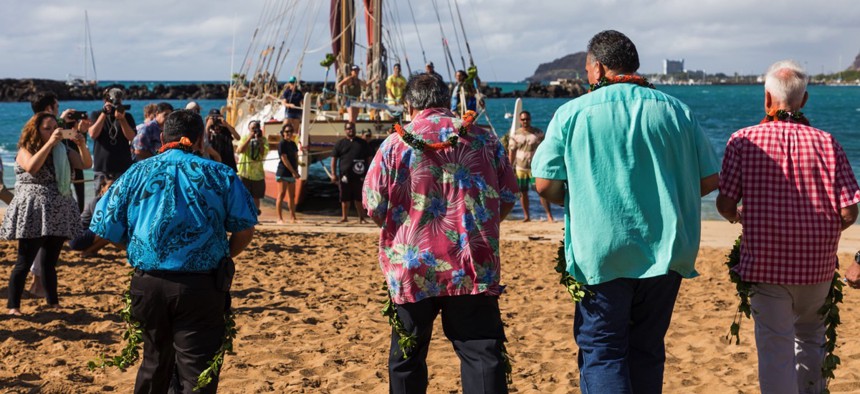Hawaii Wants All Ground Transportation on 100% Renewable Fuel Sources by 2045

From left to right: Maui County Mayor Alan Arakawa, Hawaii County Managing Director Wil Okabe, Kauai County Mayor Bernard Carvalho Jr., and Honolulu Mayor Kirk Caldwell approach the Polynesian voyaging canoe Hōkūleʻa ahead of signing their proclamations. Blue Planet Foundation
The Aloha State continues to push back against President Trump’s retreat from the Paris Agreement with aggressive climate benchmarks.
Hawaii’s mayors pledged to convert public and private ground transportation to 100-percent renewable fuel sources by 2045, making their four counties comprising the state the first in the U.S. to set such a benchmark.
The nearly decade-old Hawaii Clean Energy Initiative has seen emissions associated with electrical generation decline slowly over time. That means ground transportation’s fossil fuel consumption, which is virtually unchanged, now accounts for more than a quarter of state emissions, according to the U.S. Energy Information Administration.

“Were still in on Paris,” Josh Stanbro, Honolulu’s chief resilience officer, told Route Fifty by phone.
Honolulu Mayor Kirk Caldwell was one of the 36 U.S. mayors to sign the Chicago Climate Charter last week during the North American Climate Summit in Chicago, and his local government plans to develop a resilience strategy in 2018 for climate adaptation on the island of Oahu—spearheaded by Stanbro.
Caldwell, Maui County Mayor Alan Arakawa, and Kauai County Mayor Bernard Carvalho Jr. all signed proclamations Tuesday committing to 100 percent renewable-powered vehicle fleets by 2035. Hawaii County Managing Director Wil Okabe signed a separate proclamation making it a goal.
Both moves signal a pivot away from fossil fuels like gasoline and petroleum-based diesel.
“The stakes are too high for Oʻahu, as well as the rest of our state. We have to change our path,” Caldwell said in a statement. “With this announcement we want to send a message that we welcome the next phase of Hawaiʻi’s clean energy transformation, which will not only reduce our carbon dioxide emissions and fossil fuel imports, but will also ensure a more resilient future.”
Honolulu will begin by looking at what its fleet needs are, Stanbro said, converting portions each budget cycle beginning with some electric vehicles next year.
Building infrastructure is important so the city doesn’t go “high-centered,” he added. Carmakers like Volvo and GM have indicated plans to go electric, which could lower costs for residents, who might otherwise get stuck with internal combustion engines.
Operations and maintenance of EVs costs a third less than those reliant on fossil fuels, and the price of lithium-ion batteries used in EVs could fall from between $500 and $600 per kilowatt hour to $200 per kWh by 2020, according to global management consultant McKinsey & Company. Meanwhile, ownership of EVs has skyrocketed across Hawaii.

The signing took place in Oahu’s Pokai Bay aboard the Polynesian voyaging canoe Hōkūleʻa, which circumnavigated the globe the last three years promoting sustainability and resilience and returned shortly after Trump’s Paris Agreement decision. Hawaii’s first settlers used the wind-powered canoe to reach the islands more than 1,600 years ago.
“If Hōkūleʻa can go around the world on renewable energy,” Stanbro said, echoing words from Tuesday’s announcement. “Surely we can go down to the store on renewable energy.”
Dave Nyczepir is a News Editor at Government Executive’s Route Fifty and is based in Washington, D.C.
NEXT STORY: Traffic analysis at the intersection of AI and supercomputing






